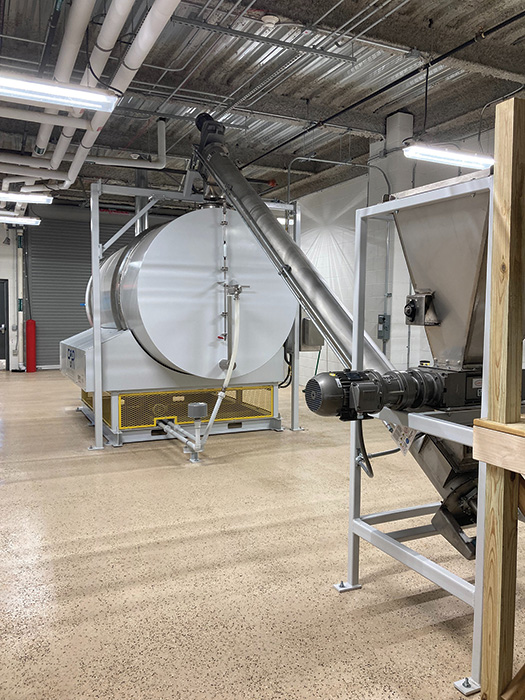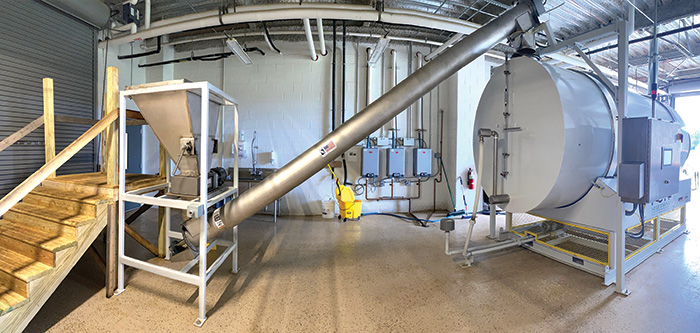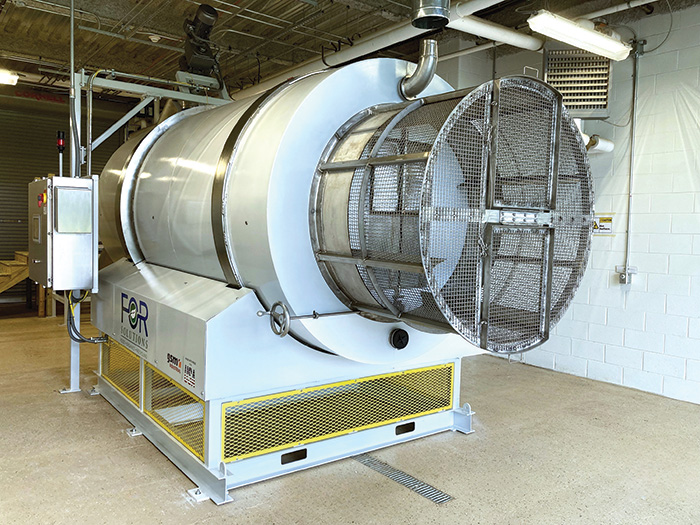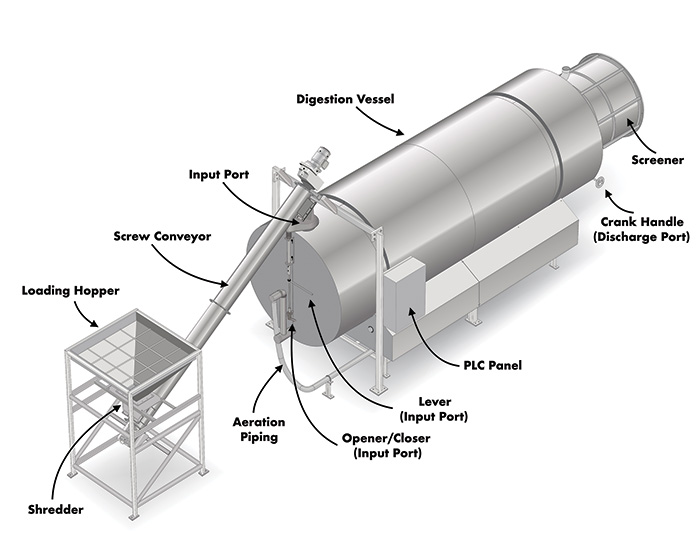How uneaten food and other organic matter are recycled will have a pivotal role in achieving the global challenge of sustainable materials management and environmental sustainability.
By Nicholas Smith-Sebasto, Ph.D.
Landfills overflowing with biodegradable materials, of which food is the most common, not only emit methane, a potent greenhouse gas, but also leach harmful pollutants into the environment. Composting, the natural process of transforming organic matter into a nutrient-rich soil amendment, offers a powerful alternative.
According to the EPA, only 5 percent of uneaten food is currently composted in the U.S. Nevertheless, aerobic in-vessel rotary drum (AIVRD) composting has emerged as one of the best practices for composting food and other organic materials. Other methods, such as windrows and static piles (whether aerated or not), are often encumbered by space requirements, odor/leachate issues, wildlife nuisance issues, pathogens, feedstock inflexibility, intensive labor, and prolonged processing periods.

Images courtesy of FOR Solutions.
What is Aerobic In-Vessel Rotary Drum Composting?
AIVRD composting is a process in which the microbial digestion of food and other organics occurs in an aerated enclosed cylinder (the vessel or drum) that rotates on its horizontal axis. Each word or phrase—aerobic, in-vessel, rotary drum—is critical to distinguishing it from other forms of composting. For example, the term in-vessel is sometimes used to describe a form of composting in which a windrow is enclosed in a tube-like covering or when the composting process occurs in what is similar to a garage with an overhead door and not all in-vessel or rotary drum composting systems are aerated.
AIVRD composting systems may be through-put loaded, which is when feedstock is added to the digestion vessel and compost is off-loaded daily once the digestion vessel is filled to its operational capacity or batch loaded—when the digestion vessel is filled to its full operational capacity in a single loading and completely off-loaded five to seven days later and the cycle is repeated.
The process starts with a stainless-steel loading hopper into which the food/organics and an appropriate bulking agent/carbon source (BA/CS) are dumped. The hopper is connected to a powerful shredder that reduces all materials to roughly the size of a standard sugar cube: raw and cooked meats, fruits and vegetables (including their husks, peels, or rinds), grains, bones, and shells, etc. This considerably increases the surface area available for microbial digestion, which contributes to the acceleration of the composting process. The shredded material drops into a fully enclosed screw conveyor; the highest-quality designs are made of stainless steel with UHMW edging on the flights. The discharge end of the screw conveyor is directly above the input port of the digestion vessel, which is where the actual composting process occurs.
To envision the digestion vessel, imagine a large, periodically rotating, double-hull drum placed on its side. Ideally, the drum is constructed of stainless steel on the inside to prevent corrosion by acidic material being composted (which food often is) and carbon steel coated with an industrial-grade epoxy enamel for the exterior. Mineral wool insulation is sandwiched between the two hulls. Inside the drum are baffles that lift and tumble the contents as it rotates. The entire drum itself is tilted downward slightly on its horizontal axis. This prevents new feedstock from mixing with older feedstock. This enclosed rotation provides key advantages over traditional static pile or windrow composting in open air environments. Consistent oxygen levels are maintained by a regenerative blower connected to an inlet aeration pipe, extending the entire length of the drum, and centered on the bottom. The is so the air can ascend through the material being composted to the exhaust pipe centered on the top of the drum, running from the input port to the end panel.

State-of-the-art AIVRD systems even include a PLC panel with an HMI interface for programmed aeration and rotation as well as other operations. Optimal carbon:nitrogen ratio and moisture are determined by the food/organics to BA/CS ratio. Combined, these environmental parameters allow aerobic bacteria to thrive. The rotating action mixes food/organics and the BA/CS so all contents experience equal conditions, preventing anaerobic pockets from forming. By avoiding a lack of oxygen, which is the cause of odors, odor is eliminated. This key distinction enables AIVRD systems to be located onsite in urban areas or inside buildings without causing odor issues. At the discharge end of the drum, a port leads to an attached screener, again made of stainless steel that screens the discharged compost as it empties from the discharge port.
AIVRD composting is characterized by the traditional mesophilic-thermophilic-mesophilic progression during a five-day minimum processing period. Food/organics break down rapidly, often within the first 24 to 72 hours. In top-of-the-line systems, temperature inside of the digestion vessel often reaches 150°F to 170°F without supplemental heat during the thermophilic phase, which kills seeds and human pathogens. The uniform conditions also mean the feedstock successfully converts into usable compost without the need for bacterial inoculants or enzymes.
Advantages of Aerobic In-Vessel Rotary Drum Composting Faster Composting
Compared to traditional composting methods that can take weeks or months, AIVRD composting can produce high-quality compost in as few as five days. This rapid turnaround enables faster resource recovery. Research has consistently shown that when compared to windrow composting, rotary drum composting produced more stable compost more quickly.
Minimal Odor and Pests
The enclosed nature of the AIVRD composting systems effectively contains any potential odors, preventing nuisance for nearby residents and attracting pests like rodents and flies. This makes it ideal for onsite or local composting initiatives. The issue of odor control extends beyond mere nuisance; it has social and environmental implications. Unpleasant odors from composting facilities can lead to public dissatisfaction and opposition, hindering the implementation of sustainable materials management practices. By using AIVRD composting, communities can mitigate these concerns, fostering a positive perception of composting initiatives and encouraging broader participation in food/organics composting programs.

Consistent Quality Compost
The controlled environment minimizes fluctuations in temperature and moisture, leading to consistent and high-quality compost rich in nutrients and beneficial microbes. This ensures optimal benefits for soil health and plant growth.
Weatherproof Operation
Unlike traditional composting, which can be impacted by weather conditions like rain and snow or prolonged excessive cold/heat or drought, AIVRD systems operate independently of the weather. Because they require such a comparatively small footprint relative to their processing capacity, they are often located inside of an enclosed structure. This ensures consistent operation and year-round production of compost.
Reduced Greenhouse Gas Emissions
Because the environmental conditions (O2 levels, C:N ratio, moisture percentage) for the microbial decomposition of the feedstock are optimized, the food and organics are efficiently digested with no anthropogenic greenhouse gas emissions when operated as designed.
Versatility
AIVRD systems can handle a wide variety of organic materials, including food scraps, yard trimmings, biosolids, and even animal manure/mortalities. This flexibility accommodates diverse waste streams, maximizing resource recovery potential.
Space Efficiency and Scalability
AIVRD systems, with their small footprint and scalability, offer a practical and sustainable response to the challenges of space-constrained materials management environments. The spatial efficiency of AIVRD composting is no small matter (pun intended) for urban planners and waste management authorities. As the growth of cities continues and space becomes even more of a premium commodity, the ability to implement composting solutions with minimal spatial requirements becomes paramount. Furthermore, the modular design of AIVRD composting allows for scalability, enabling facilities to expand their composting capacity as the need arises.

Plug-and-Play
Flagship AIVRD composting systems are fully functional systems that require only a scale to weigh the food/organics and the BA/CS and a receiving vessel for the discharged compost. In most areas, an enclosed structure with 208V, three–phase, 60A electrical service will be required with supplemental heat if daily temperatures drop below 40°F for more than 24 hours and water service. Water is not required for the operation of industry leading AIVRD composting systems; rather, it is necessary for general sanitation and for operators to be able to wash their hands.
An Important Piece
In 2013, the Institute for Local Self-Reliance (ILSR), “a national non-profit research and technical assistance organization that since 1974 has championed local self-reliance, a strategy that underscores the need for humanly scaled institutions and economies and the widest possible distribution of ownership” released a report titled Pay Dirt: Composting in Maryland to Reduce Waste, Create Jobs, & Protect the Bay (a research effort that richly deserves to be replicated in other states). In it, the ILSR suggested, “Locally produced compost is a valuable soil amendment for local food production. …” It further recommended, “What is needed is a highly decentralized and diverse organics recovery infrastructure that … prioritizes … onsite institutional systems … before the development of centralized regional facilities” and “the state’s composting operations, on a per-ton and a per-dollar-capital-investment basis, sustain more jobs than its landfills or incinerators. … Hundreds of new jobs could be created if organic material was diverted from landfills and incinerators to composting facilities. The potential job creation would increase if a diverse composting infrastructure was developed, that included many small- and medium-sized operations.” The question becomes: how are small- and medium-sized food/organics sustainable composting operations created? Clearly, aerobic in-vessel rotary drum composting as a best practice is an important, if not indispensable, piece of that sustainability puzzle. | WA
Nicholas Smith-Sebasto, Ph.D. is the Founder and CEO of FOR Solutions, LLC, a biotechnology company that offers patented OSHA-compliant aerobic in-vessel rotary drum composting systems. Laboratory analyses by USCC STA-Certified labs have consistently found that compost produced in FOR Solutions composting systems is mature, stable, pathogen-free, and nutrient-dense upon discharge from the digestion vessel. Nicholas can be reached at [email protected] or visit www.FORSolutionsLLC.com
